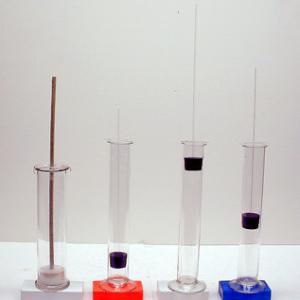College of Liberal Arts & Sciences
4F30.96 - Carnot Engine
The cylinders with the plungers and heat sinks are used to show the Carnot cycle at different stages.
The computer program 'Thermodynamics' has a good computer animation of a Carnot cycle complete with temperature and pressure curves.
- Bruce Cameron Reed, "A Deeper Look at the Sadly Carnot Thermodynamic Cycle", TPT, Vol. 61, #5, May 2023, p. 331.
- Trevor C. Lipscombe and Carl E. Mungan, "Breathtaking Physics: Human Respiration as a Heat Engine", TPT, Vol. 58, #3, Mar. 2020, p. 150.
- "Carl E. Mungan, “Entropic Damping of the Motion of a Piston,” Phys. Teach. 55, 180–183 (March 2017)", TPT, Vol. 55, #4, Apr. 2017, p. 196.
- Carl E. Mungan, "Entropic Damping of the Motion of a Piston", TPT, Vol. 55, #3, Mar. 2017, p. 180.
- P.-M. Binder and C. K. S. Tanoue, "Variations on the Zilch Cycle", TPT, Vol. 51, #7, Oct. 2013, p. 434.
- Harvey S. Leff, "A Reminder for Us All", TPT, Vol. 34, #3, Mar. 1996, p. 134.
- Michael J. Nolan, "Thermodynamic Cycles—One More Time", TPT, Vol. 33, #8, Dec. 1995, p. 573.
- David S. Mills and Craig S. Huston, "The 'Sadly Cannot' Thermodynamic Cycle Revisited", TPT, Vol. 29, #3, Mar. 1991, p. 180.
- Minghua Chen, "An Electrical Model of a Carnot Cycle", TPT, Vol. 27, #4, Apr. 1989, p. 272.
- A. J. Nicastro, "A Dynamic Model of a Carnot Cycle", TPT, Vol. 21, #7, Oct. 1983, p. 463.
- Mario Iona, "The Two-Stroke Heat Engine", TPT, Vol. 18, #5, May 1980, p. 336.
- Jack Willis and Donald F. Kirwan, "The 'Sadly Cannot' Thermodynamic Cycle", TPT, Vol. 18, #1, Jan. 1980, p. 51.
- Randall D. Knight, "Heat Engines with Finite Reservoirs", AJP, Vol. 92, #10, Oct. 2024, p. 759.
- Jacques Arnaud, Laurent Chusseau, and Fabrice Philippe, "A Simple Model for Carnot Heat Engines", AJP, Vol. 78, #1, Jan. 2010, p. 106.
- Don S. Lemons and Margaret K. Penner, "Sadi Carnot's Contribution to the Second Law of Thermodynamics", AJP, Vol. 76, #1, Jan. 2008, p. 21.
- Tomáš Opatrný, "The Maser as a Reversible Heat Engine", AJP, Vol. 73, #1, Jan. 2005, p. 63.
- E. Rebhan, "Efficiency of Nonideal Carnot Engines with Friction and Heat Losses", AJP, Vol. 70, #11, Nov. 2002, p. 1143.
- J. Güémez, C. Fiolhais, and M. Fiolhais, "Sadi Carnot on Carnot's Theorem", AJP, Vol. 70, #1, Jan. 2002, p. 42.
- M. Howard Lee, "Carnot Cycle for Photon Gas?", AJP, Vol. 69, #8, Aug. 2001, p. 874.
- Harvey S. Leff, "Thermal Efficiency at Maximum Work Output: New Results for Old Heat Engines", AJP, Vol. 55, #7, July 1987, p. 602.
- E. Rebhan and B. Ahlborn, "Frequency-Dependent Performance of a Nonideal Carnot Engine", AJP, Vol. 55, #5, May 1987, p. 423.
- Harvey S. Left, "Heat Engines and the Performance of External Work", AJP, Vol. 46, #3, Mar. 1978, p. 218.
- F. L. Curzon and B. Ahlborn, "Efficiency of a Carnot Engine at Maximum Power Output", AJP, Vol. 43, #1, Jan. 1975, p. 22.
- G. S. Kell, "Heat Engines that Use a Gravitational Field", AJP, Vol. 42, #3, Mar. 1974, p. 209.
- A. H. Kalantar, "Carnot Cycle Diagrams", AJP, Vol. 34, #10, Oct. 1966, p. 979.
- Steve K. Blau, "Efficiency Bounds for Powerful Engines", Physics Today, Vol. 63, #11, Nov. 2010, p. 18.
- Kerry Emanuel, "Hurricanes: Tempests in a Greenhouse", Physics Today, Vol. 59, #8, Aug. 2006, p. 74.
Disclaimer: These demonstrations are provided only for illustrative use by persons affiliated with The University of Iowa and only under the direction of a trained instructor or physicist. The University of Iowa is not responsible for demonstrations performed by those using their own equipment or who choose to use this reference material for their own purpose. The demonstrations included here are within the public domain and can be found in materials contained in libraries, bookstores, and through electronic sources. Performing all or any portion of any of these demonstrations, with or without revisions not depicted here entails inherent risks. These risks include, without limitation, bodily injury (and possibly death), including risks to health that may be temporary or permanent and that may exacerbate a pre-existing medical condition; and property loss or damage. Anyone performing any part of these demonstrations, even with revisions, knowingly and voluntarily assumes all risks associated with them.
